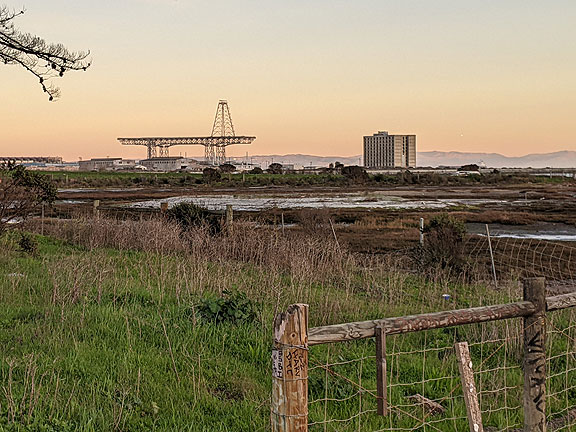
Easterly view over Parcel E of the former Hunters Point shipyards, probably the most radioactive and toxic site in any city in the U.S.
I’ve been following the State of California’s slow-moving effort to determine whether or not it should take responsibility for providing reparations for African Americans for historic crimes and systematic racism. The official body in charge of this process is already furiously pedaling backwards as the right-wing echo chamber amplifies false exaggerations that every black Californian is going to be eligible for a $1.2 million payout from the state. If only!
I support paying reparations to folks whose ancestors were held in slavery. I also support paying reparations to people whose families have persisted through a further century of Jim Crow racism, redlining and restrictive covenants, systematic disinvestment, and myriad forms of exploitation both obvious and subtle. California has a deeply racist history that is sometimes overlooked in the present era of self-congratulatory “Blue State” liberal hegemony. If not overlooked, the deep structural and social racism that shapes life in California to this day is downplayed in favor of the Obama-ish invocation of progress and earnest intentions to do better. But any unblinkered examination of California’s history, including the Bay Area and certainly including San Francisco itself, quickly comes face to face with legacies of blatant racism that clearly still influence much of our daily lives.
A while ago I read Eugenic Nation: Faults & Frontiers of Better Breeding in Modern America, by Alexandra Minna Stern (University of California, 2nd edition, 2016), which is an excellent survey of how deeply eugenicist politics influenced assumptions underlying public health, national borders and immigration, education, and more. How many people know that at the 1915 Panama-Pacific International Exposition in San Francisco an organization called the “Race Betterment Association” had a prominent booth, and held a convention that brought to San Francisco prominent racist and eugenicist figures from around the state? Or that the ideas of “race betterment” that were honed by this association and a couple of others were embraced by the Nazi government in Germany by 1934, where they were partly inspired by official California sterilization policies to begin their own racial purity campaigns?
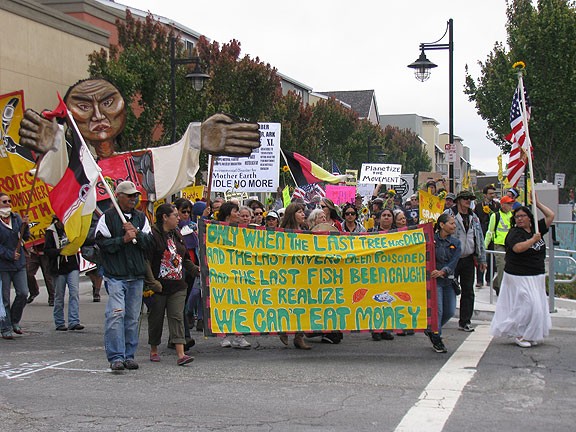
Protesters in 2013 in Richmond march on Chevron, pointing out the obvious: you can’t eat money!
The progressive Bay Area is very proud of its incredible history of environmental resistance to the depredations of untrammeled modernism and the imperatives of speculative capital. But few realize that the men who launched the Save the Redwoods League at the beginning of the 20th century were prominent eugenicists. As Stern argues, “Saving the redwoods meant more than just protecting a tree; it was a metaphor for defending race purity and ensuring the survival of white America … Nonetheless, the alliance between eugenic racism and environmentalism, which seemed quite natural to the founders of both movements, continues to flicker on and off in the twenty-first century in the xenophobic platforms endorsed by the population section of the Sierra Club, and sometimes in the rhetoric employed to campaign for greenbelts, no- or slow-growth polices, and strict zoning codes.” (p. 148, 151)
Eugenics was widely discredited by the holocaust and Nazi concentration camps, but its ideas had by then been “naturalized into federal, state, and even municipal institutions and were underpinning postwar norms of conformity.” (p. 177) It wasn’t until the 1940s that anti-miscegenation laws were repealed in California, but by then an entire generation of Filipino men, to cite one example, had lived without the ability to bring over spouses or families from the Philippines, nor were they officially allowed to marry women of other races. Sundown towns were known throughout California—San Leandro for example enforced its border with Oakland quite vigorously well into the late 20th century.
In another book I read a couple of weeks ago, The Bonds of Inequality: Debt and the Making of the American City, Destin Jenkins brilliantly dissects the profoundly racist operation of the municipal bond market in San Francisco dating back to the immediate post-WWII period. Bond merchants and banks, where their obscure offices were tucked, had been thoroughly exposed as incompetent and (often) corrupt by the Great Depression. New Deal banking reforms, ironically, gave those very same bond sellers and banks a new lease on life by giving them control of a strategically vital lever of power in any urban area: the spigot of capital for infrastructure investment. Determined to resuscitate and “save” capitalism, New Deal banking reforms didn’t just overcome the Depression (albeit with a big boost from military spending during WWII that continued ever since). As Jenkins convincingly argues, “For near thirty years, federal guarantees for bondholders did more than provide commercial banks with liquidity, profits, and dividends for shareholders: the federal government helped unlock banker prosperity.” (p. 191)
By the 1970s, rising inflation and unemployment as deindustrialization swept away large parts of U.S. manufacturing led to the fiscal crisis of the state. Municipal bond markets by then had sustained decades of tax-dodging profitability. The bond market is a system where the wealthy could purchase federally tax-exempt bonds (and avoid paying the prevailing high tax rates), while enjoying rigid guarantees that their investments and the interest they charged municipalities (as the price for providing funds for schools, parks, sewage and water systems, roads and freeways, etc.), would be paid back ahead of all other priorities in city finances. Our contemporary crisis of crumbling infrastructure can be traced directly to this self-defeating arrangement of depending on the rich for debt financing, rather than a robust system of taxation that would actually be subject to some version of democratic controls. As Jenkins says, “It was in the crucible of high interest rates and dependence on lenders that the deterioration of urban infrastructure accelerated.”
More importantly, Jenkins has framed his exposé in terms of the underlying racism that shaped San Francisco and U.S. cities more broadly.
During a moment of historically low interest rates [in the 1940s and 50s], black neighborhoods were continuously deemed unworthy of debt. The twenty-year moment when money was cheap is marked by what I call the infrastructural investment in whiteness. (p. 15) … Infrastructure was … not only a means of achieving economic growth by accommodating the white consumer, tourist, and executive; it also symbolized an investment in middle-class whiteness per se. From public parks and museums to roads and parking garages, infrastructure was an expression of white rights, of the expectation of an expansive public. Offering a San Francisco twist to the Keynesian city, streets, parks, and museums were repurposed in service of “state-backed, debt-financed consumption.” Just as federally guaranteed mortgages propelled white middle-class suburbanization, municipal debt made possible the well-paved streets, downtown parking garages, new sports arenas, and rehabilitated art spaces for the white middle- and upper-class urbanite. White construction workers in segregated building trades enjoyed the spoils by literally building the consumer playground and upgrading crumbling cultural landmarks. (p. 69-70) … San Francisco’s infrastructural investment in middle-class whiteness was grounded in its working-class companion, the segregated building trades… In San Francisco during the 1950s and early 1960s, skilled construction jobs were for white men, and the city’s building trade unions worked to keep it that way. (p. 79)
When the U.S. Supreme Court outlawed racially restrictive covenants on neighborhood residency in 1948, for the first time middle-class residents of Chinese and Japanese descent began moving into the Sunset and the Richmond districts. Black families who could afford to were able to buy properties in the Outer Mission/Ingleside area in the southwest. And public housing projects under the management of the San Francisco Housing Authority (SFHA) was required to desegregate too; finally the previously all-white Valencia Gardens at Valencia and 15th opened up to Latinos, Asians and African Americans. This story is somewhat well known, at least to those who have looked into it. Less well understood is that the SF Housing Authority depended on its own version of municipal bonds to operate public housing projects. By 1958 the SFHA had become the City’s largest landlord with 4250 units in fourteen permanent projects. Jenkins is at his best in explaining what this relationship meant for the evolution of public housing here:
Through debt, the San Francisco Housing Authority came to house poor residents while providing safe investment outlets for bondholders. (p. 109) By locating public housing in redlined areas and issuing tax-exempt, federally guaranteed debt, the SFHA inadvertently monetized the city’s most devalued lands in new ways. Suddenly, redlined neighborhoods, once defined by racial threats, slum dwellings, and “unpleasant odors” from nearby stockyards and packing plants, were outlets for institutional capital. (p. 95) … Rather than fund the construction, upkeep, maintenance, and beautification of crumbling housing projects, bankers used the absence of interest rate restrictions on short-term public-housing debt to capture income. While public housing authorities were bled dry, Bank of America increased its holdings of Public Housing Authority notes from $165 to $270 million between December 31, 1964 and September 15, 1965. (p. 99) [emphasis added] … The debtor-creditor arrangement did more for the institutional capital than for the tenants who lived in the housing it funded… What made the public-housing arrangement unique was that the layers of guarantees, protections, and hierarchy of claims betrayed in a most glaring way the divergent interests of borrowers and bondmen, tenants and creditors. In a sense, the program became a laboratory for the profitability of poverty and how short-term debt could mollify the cost-profit squeeze of bondmen. (p. 100) … The deterioration of public-housing projects was taken as proof of the failures of socially oriented public policies rather than as a consequence of a structural arrangement that, from the beginning, privileged the claims of bondholders. (p. 109) While maintenance costs [at SFHA projects] rose around 13 percent between 1963 and 1966, rental income rose just 3 percent. The “wanton destruction of buildings” necessitated hiring glaziers to recut and replace broken windows. The SFHA blamed window breakers without entertaining how inflation, dependence on an extractive market, and the prioritization of lenders over tenants also contributed to escalating maintenance costs. (p. 122)
There is a great deal more in Jenkins’ excellent book. He shows how the infamous “structural adjustment” that was imposed on Third World countries like Mexico and Nigeria in the wake of the debt crisis created by profligate lending of recycled petro-dollars (after the 1973-74 “oil crisis”) got its first use on municipalities in the U.S.
Put simply, structural adjustment emerged out of the contingencies of municipal debt and entailed cuts for ordinary people and guaranteed rents and protections for bondholders. In addition, municipal borrowers truncated long-term political horizons. Paying the next bill took precedence over addressing the social crisis of austerity. (p. 218)
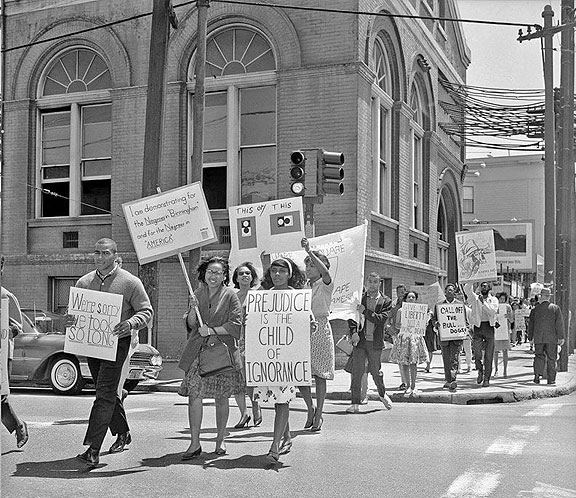
Civil rights protesters at Turk and Fillmore Streets, 1963.

Police officers threaten protesters during Hunters Point Uprising, September 1966.
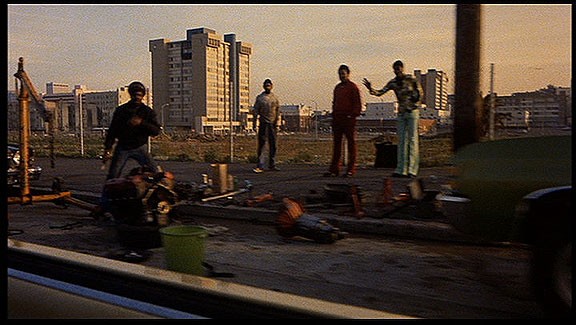
Streetside car repair in 1978 along the many blocks of the Fillmore bulldozed by Redevelopment.
After reading his book one can hardly fail to see the deep structural racism that has shaped San Francisco, its neighborhoods, its economy, and its priorities and produced the long-term impoverishment of Black San Franciscans. And the kinds of problems seen here are endemic to nearly every major city in the country. The shift of bonds away from building public infrastructure to financing revenue-generating activities since the 1970s has opened new ways for the rich to get richer. For one example, it led to our rising water bills:
San Franciscans approved a $104 million revenue bond to finance water system improvements in November 1984… Assuming a maturity of thirty years [controller John C.] Farrell estimated that interest payments would total a whopping $169.2 million. Water had become another conduit for delivering millions of dollars to revenue bondholders. (p. 211)
At an earlier point in the book Jenkins references the collapse of insurance availability for black businesses after the Martin Luther King Jr. assassination and riots. Similarly in San Francisco after the September 1966 Hunters Point Uprising, merchants along Third Street were unable to recover losses from their insurers, and further coverage proved impossible to obtain. In a section describing how voters turned against bond initiatives in greater numbers during the late 1960s and early 1970s, precursors to the reactionary Proposition 13 tax revolt of 1978, Jenkins reveals a long-forgotten moment when voters rejected a new “Southern Crossing” bay bridge 384,245 to 114,132. Curiously, Jenkins interprets this sensible rejection as a racist repudiation “of black industrial futures.”
In this his analysis dovetails with the pro-growth critique mounted by Alex Schafran in The Road to Resegregation: Northern California and the Failure of Politics (University of California Press: 2018). Everyone knows that the black population of San Francisco has been steadily moving out for years. More than 100,000 African Americans left San Francisco, Oakland, and Berkeley in the last 25 years, many of them moving to the cities of Eastern Contra Costa County like Antioch and Pittsburg, or further out into the Central Valley to Stockton or Tracy. Recent scandals in Antioch’s corrupt and racist police department show how much the same dynamics prevail, reproducing the same kind of racist policing that has long plagued other cities in the Bay Area. Analyzing the profound political fragmentation of the greater metropolitan region, Schafran provides a uniquely wide view of a dynamic process that connects the disparate zones of the Bay Area and its outer fringes. Rather than narrowing the focus to how long-segregated neighborhoods in the core cities of the region have been slowly changing their demographics, Schafran finds that the racist logic that produced those neighborhoods has been reinvented on a regional basis.
The region’s incredible record of economic and social innovation and environmental preservation was matched by similar innovation in racial exclusion and outright bigotry. Moreover, the radicalism and innovation for which it became famous never materialized into a similar world-class effort to overcome those spatialized inequalities and divisions that the collective racism produced. (p. 16)
He spends a lot of the book detailing the battles over growth politics that erupted in Contra Costa County, and shows how the county is split into three distinct regions, East, West, and Central, with the latter being the beneficiary of expansive federal and state spending during earlier decades. West County is mostly the city of Richmond, one of the poorest cities in the Bay Area with a large black population. And East County is as he calls them the “Cities of Carquinez,” stretched along the southern shore of Carquinez Strait, Suisun Bay, and the San Joaquin River: Concord, Pittsburg, Antioch, Martinez.
Unlike more urban areas, where pro-growth politics are often contested by powerful community organizations focused on affordable housing, the rights of the homeless or low-income groups, or racial or ethnic-based politics, growth politics at the county level in Contra Costa began primarily as a matter of green versus growth, with critical consequences. A primarily white, middle-class movement, the environmental and anti-/slow-growth activists focused mainly on questions of preservation—preserving quality of life, preserving the environment. (p. 103)
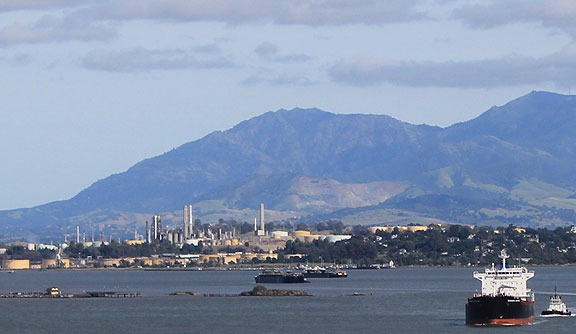
Mt. Diablo looming behind refineries dotting the cost of East Contra Costa County.

Refinery and pipeline in Martinez.
Fueled equally by progressive and traditional conservative energies, the anti-sprawl movement sought to limit urban growth along the I-680 corridor as much as possible. From Schafran’s regional point of view, the campaign to block the suburban development of Doughtery Valley near Pleasanton made no sense. Granted, it wasn’t an example of the kind of urban infill much loved by 21st century environmentalists and new urbanists, but it was an example of what could have been viewed as regional infill according to Schafran. Of course this only makes sense if one concedes that incessant economic growth is necessary and unavoidable.
Looking at Marin County as the quintessential example of the place in the Bay Area that avoided pell-mell suburbanization and sprawl, Schafran highlights how its success on one front was also its utter failure on another.
…no single factor fragmented the region like the ghosts from the earlier era—the echoes and memories of a modernist, postwar growth machine and planning apparatus that was as environmentally destructive as it was racist. Marin County became a national leader in pushing back against many of the excesses of the growth machine, fighting freeways and habitat destruction in a 1960s political rebellion that would forever alter county politics. This strong environmental streak would help to flip the county from Republican to Democrat, and make it a pioneer in open space preservation and park-building. But along the way, this deep opposition to one sin of the modernist era also led it to become one of the worst reproducers of the other cardinal sin of the very same era. (p. 174-175)
Early environmental organizing began in the 1930s when women in the Marin Garden Club anticipated the rapid growth that the new Golden Gate Bridge would bring. Residents organized to block transportation infrastructure for decades, recognizing that growth could only be controlled by preventing the enabling transit systems, whether highways, bridges, or trains. The successful effort to block an expanded freeway through the Marin Headlands and up the west side of the county was one element. Another was the prevention of a second bridge from San Francisco’s Telegraph Hill to Angel Island and on to the Tiburon Peninsula. BART directors actually asked Marin County to pull out because they didn’t think 2/3 of Marin’s voters would support extending BART northward over the Golden Gate Bridge.
[Marin County] prided itself on being one of the most environmentally progressive places on earth, but its housing and transportation politics had exacerbated polluting traffic and made no small contribution to millions of regional residents being forced farther out from the core in search of housing. (p. 183)
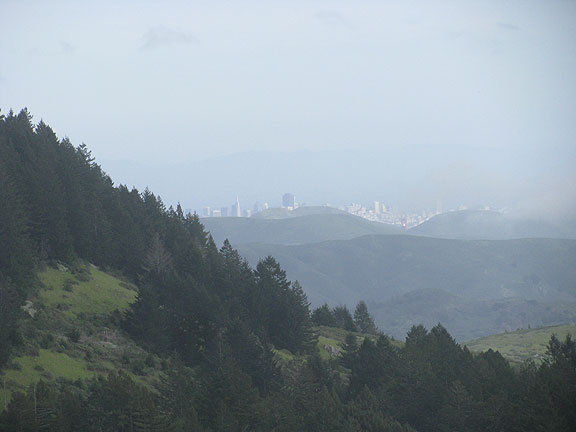
The San Francisco skyline is visible over many open hills of Marin County, as seen from Mt. Tamalpais in 2010.
I really enjoyed Schafran’s book. And I think he contributes, too, to an understanding of the long-term effects of racism that reparations is meant to address. But I don’t entirely agree with his framing and politics. I think he’s right to criticize the persistence of political organizing that is stuck on addressing the gentrifying core to defend low-income populations, mostly people of color, from eviction. As he reminds readers, many members of these communities have freely chosen to move to the suburbs for similar reasons white working class people did in past generations: for “breathing space, safety for their children, the American dream, or just to follow a friend or relative.”
This core-centic strategy, necessary to defend low-income communities still hanging on, fit together with the smart-growth consensus and made allying with longtime opponents easier. But it ignored the fact that in the current era of mobile segregation, the right to a fiscally sound, transportation-enabled and viable suburb must be considered alongside the right to the city as a critical social and racial justice issue. This is the right to the metropolis, a right that has never been truly represented by either attempts to preserve, defend, or enhance the right to the city or efforts to ‘open up the suburbs.’ (p. 232)
Taking up the same cudgel wielded by Jenkins’ book on the bond market, Schafran blames environmentalists and anti-growth campaigners for not finding a more expansive vision of preservation that would make room for a kind of economic growth that would benefit populations systematically blocked from benefiting from past growth.
… environmentalists lost the opportunity to prove that their dark past, with connections to eugenics and blatant anti-immigrant sentiment, was behind them, and that theirs was not simply a white, affluent, and elitist cause. (p. 237)
There is no doubt that lots of wealthy white environmentalists were largely focused on campaigns that would preserve their own views and access to open spaces, their air and water quality, etc. But for more than 50 years, plenty of environmentalists and organizations of all races have foregrounded an urban-focused environmental justice orientation that addresses the quality of life in core communities AND opposes boondoggles like a second Bay Bridge, or the industrial development of western Marin, or any of a number of other misguided notions. Schafran works hard to sound reasonable and probably succeeds for many when he suggests that “metropolis-building always requires a complex mix of institutions, capital, labor, and materials, and starts from this point. It does not start from an ideological viewpoint about states, markets, certain types of institutions, or scale of engagement.” (p. 262) I couldn’t disagree more! There is nothing reasonable about conceding the ground to capital and its fully-owned institutions of local and regional governance. This is precisely what got us here in the first place.
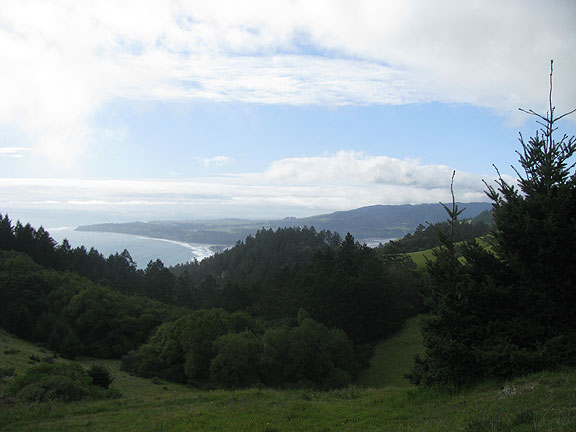
Bolinas in the distance along the Pacific Ocean from Mt. Tamalpais.
But I can agree with Alex Schafran when he says “In order to change the game, we must begin to see that systems like housing, transport, public space, education, food, water, health care, etc.–what … I call foundational urban systems—should be the primary purpose of twenty-first-century politics.” (p. 261) I argue that these are precisely the systems that must be entirely decommodified, that have to be taken out of market logic and subjected to self-managed community design and control. And further, that each person has an inalienable right to all those items, regardless of how much or how little they work. Rather than call for a reconstructed growth machine, even one animated by new ways of doing business, as Schafran does, I think it’s high time we look at how we could reorganize our shared lives here to guarantee everyone has the high quality housing, transit, food, etc. that should be the simple certainty of any human life. And that can only be meaningfully ensured by repairing the ecological web of life on which we all depend, a task that we at best could only begin modeling, and do our best to see that people in other areas take it up too. However expansive our mega-region is defined as, we are still only one small part of the vast global process of making life for billions of people, and countless trillions of other forms of life. We’re all in it together, and we have to find a way to live that breaks the propulsive logic of perpetual growth that capitalism has led so many to believe is inevitable. It is not.
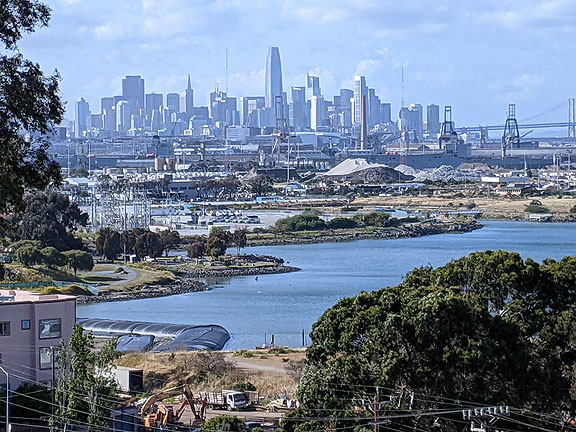
Downtown from Hunters Point ridge, with India Basin and site of former power plant in left foreground. This part of San Francisco was left out of the city’s booms for so long.
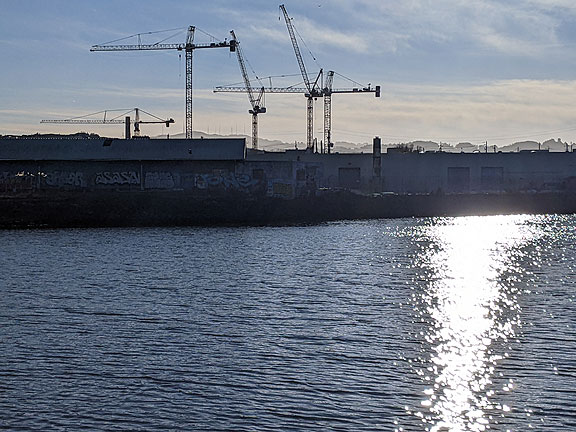
The main sewage plant in San Francisco on Oakdale, built where Butchertown’s tanneries once stood along the Islais Creek marshes, is being rebuilt to withstand sea-level rise. From the northern shore of Islais Creek, it’s a couple of blocks south.
For the generations of African Americans who have come here to live, escaping slavery, escaping the most dire forms of Jim Crow brutality, San Francisco did not prove to be much of an answer. The kinds of insidious discrimination and violence inflicted on our own black population has to be repaired. Reparations, real cash, is a gesture in the right direction. Changing life more profoundly for everyone would be a much greater way to make such treatment for anyone impossible in the future.












Reparations is an excellent subject for political criticism – William Darity’s and A. Kirsten Mulle’ns 2020 second edition of “From Here to Equality: Reparations for Black Americans in the 21st Century” is a masterfully researched and presented brief in favor of truly massive US governmental reparations, but they do not advocate piecemeal or institution-by institution or state-by-state gestures, but a comprehensive, economically sound real deal. This is in line with what you aver about the limited scope of California’s Bay Area, “we are still only one small part of the vast global process of making life for billions of people, and countless trillions of other forms of life.”
Of course, national reparations is exactly what Black America, and Native America and other victims of American holocausts will never get, but as Debbie Harry sang, “dreamin’ is free…”